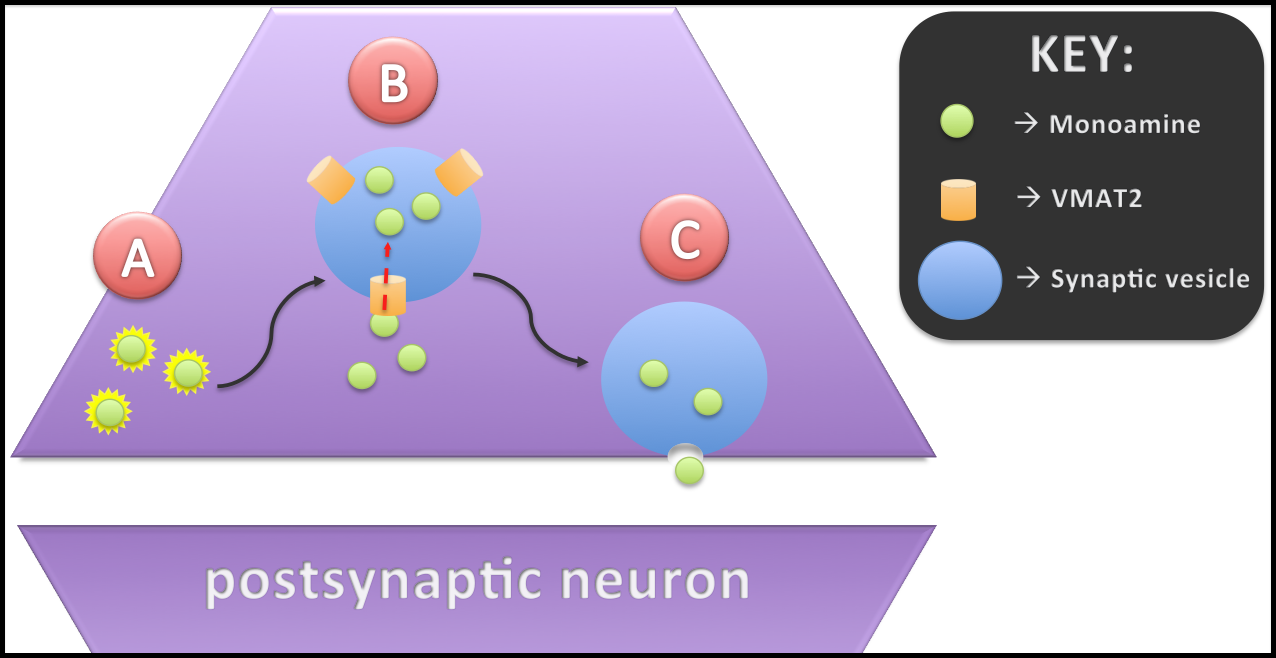

This web page was produced as an assignment for an undergraduate course at Davidson College.
The Gene
The gene SLC18A2 was mapped to chromosome 10q25, denoted by the red line below, by Surratt et al. (1993) using Southern Blot analysis and fluorescence in situ hybridization:

Image compliments of GeneCards
Orthologs for SLC18A2 have been identified in a variety of other species, including chimpanzee (P. troglodytes), dog (C. familiaris), cow (B. taurus), zebrafish (D. rerio), rat (R. norvegicus), mouse (M. musculus), chicken (G. gallus), fruit fly (D. melanogaster), worm (C. elegans), and even mosquito (A. gambiae).
In humans, microarray analysis of SLC18A2 has detected expression of the gene in a variety of tissues:

Microarray expression graph compliments of GeneNote. GNF stands for the Genomics Institute of the Novartis Research Foundation. Normal versus Cancer desribes the tissue from which the mRNA was extracted.
The Protein
SLC18A2 encodes VMAT2, or vesicular monoamine transporter. According to OMIM, VMAT2 is expressed on the vesicle membranes within the presynaptic neuron, where it utilizes the membranes' proton gradients to pump monoamine neurotransmitters (dopamine, norepinephrine, serotonin, and histamine) from the cytosol into the vesicles. The transmitter-containing vesicles are then released into the synaptic cleft, passing along the chemical signal to the postsyanptic neuron. Therefore, communication within these monoaminergic pathways relies in large part on proper functioning of VMAT2.


Note: the three-dimensional structures of monoamine transporters are not yet characterized, but molecular modeling techniques using the E. coli sodium/hydrogen antiporter have afforded some predictions of a general model (Ravna 2006). GeneCards reports VMAT2 as a multi-pass membrane protein. In addition, VMAT2 has one isoform, VMAT1, which is encoded by SLC18A2.
Clinical Connections
As a facilitator of synaptic transmission, VMAT2 plays a crucial role in neural communication. Therefore, alteration of this process has the potential to induce great changes to a delicate, carefully balanced system. Not surprisingly, dysfunction of VMAT2 has been implicated in a variety of degenerative and neuropsychiatric disorders, including Parkinson's Disease, Depression, and Schizophrenia.
Next...
Popular Press vs. Scientific Literature
Genomics Page
Biology Home Page
Email questions or comments to kaswart@davidson.edu.
© Copyright 2011 Department of Biology, Davidson College, Davidson, NC 28035